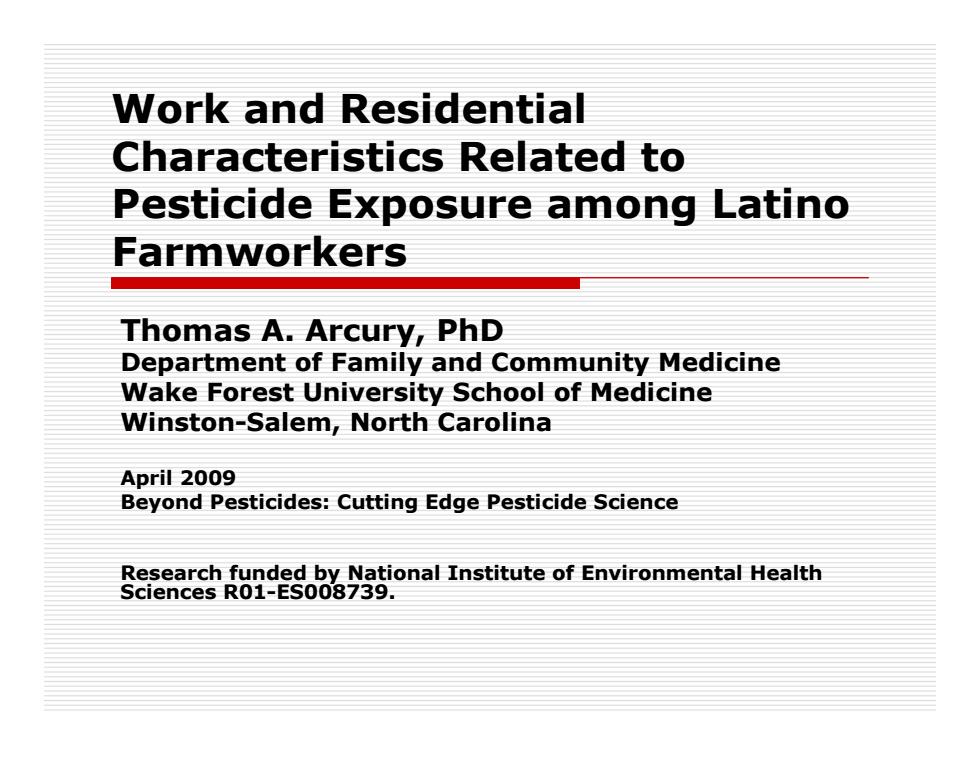
Work and Residential Characteristics Related to Pesticide Exposure among Latino Farmworkers Thomas A.Arcury,PhD Department of Family and Community Medicine Wake Forest University School of Medicine Winston-Salem,North Carolina April 2009 Beyond Pesticides:Cutting Edge Pesticide Science Research funded by National Institute of Environmental Health Sciences RO1-ES008739
Work and Residential Characteristics Related to Pesticide Exposure among Latino Farmworkers Thomas A. Arcury, PhD Department of Family and Community Medicine Wake Forest University School of Medicine Winston-Salem, North Carolina April 2009 Beyond Pesticides: Cutting Edge Pesticide Science Research funded by National Institute of Environmental Health Sciences R01-ES008739
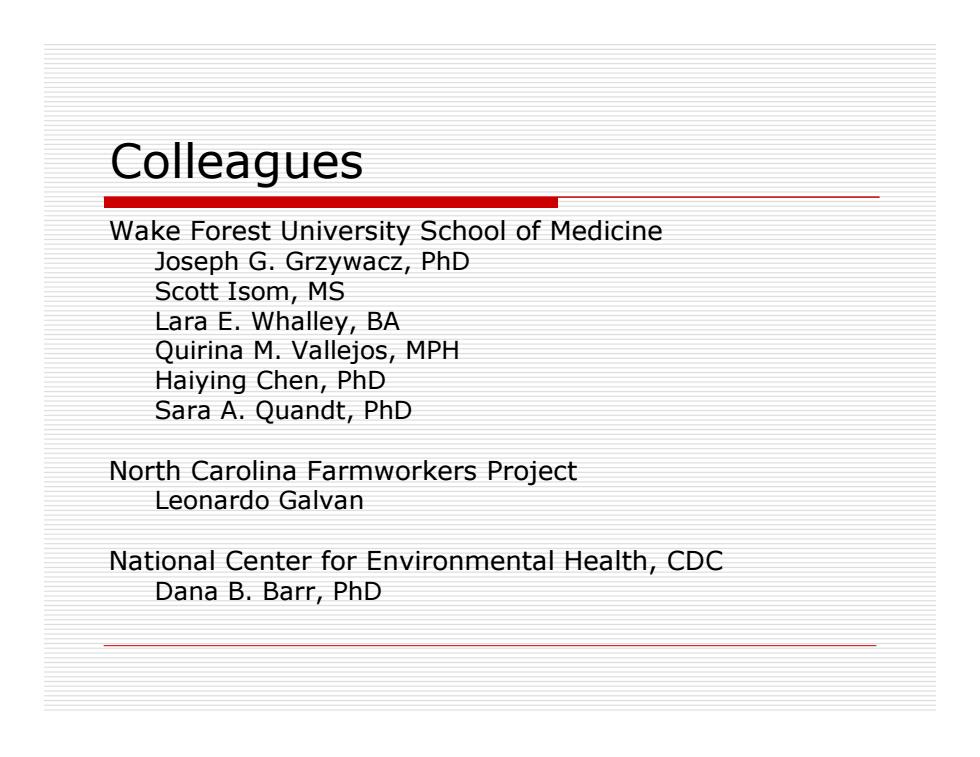
Colleagues Wake Forest University School of Medicine Joseph G.Grzywacz,PhD Scott Isom,MS Lara E.Whalley,BA Quirina M.Vallejos,MPH Haiying Chen,PhD Sara A.Quandt,PhD North Carolina Farmworkers Project Leonardo Galvan National Center for Environmental Health,CDC Dana B.Barr,PhD
Colleagues Wake Forest University School of Medicine Joseph G. Grzywacz, PhD Scott Isom, MS Lara E. Whalley, BA Quirina M. Vallejos, MPH Haiying Chen, PhD Sara A. Quandt, PhD North Carolina Farmworkers Project Leonardo Galvan National Center for Environmental Health, CDC Dana B. Barr, PhD
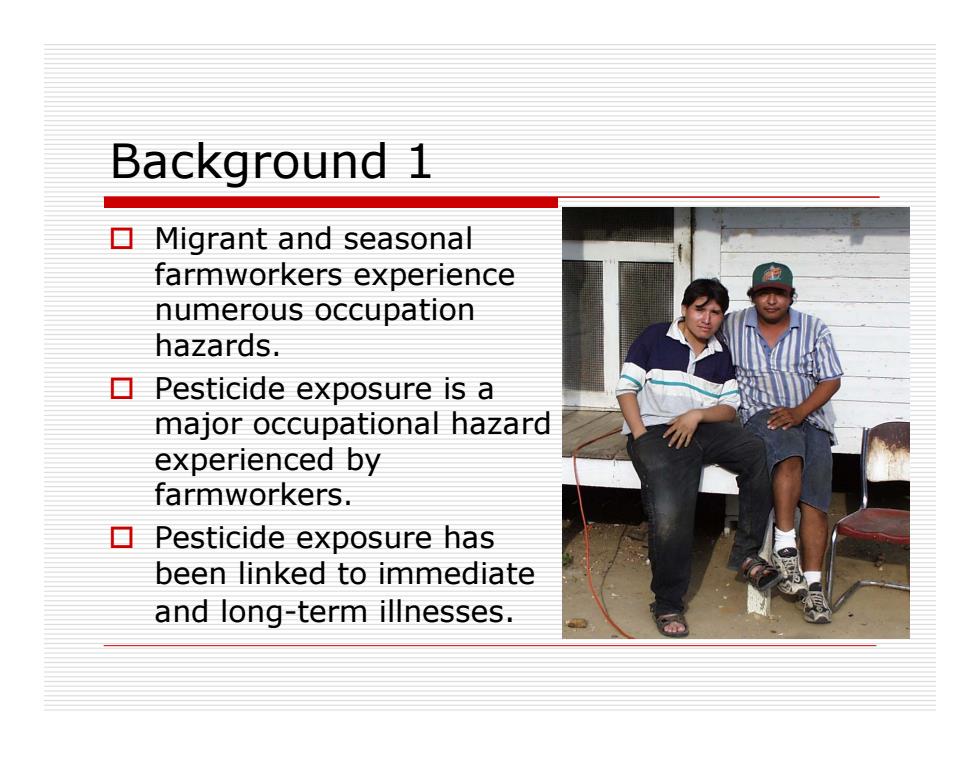
Background 1 ▣Migrant and seasonal farmworkers experience numerous occupation hazards. Pesticide exposure is a major occupational hazard experienced by farmworkers. Pesticide exposure has been linked to immediate and long-term illnesses
Background 1 Migrant and seasonal farmworkers experience numerous occupation hazards. Pesticide exposure is a major occupational hazard experienced by farmworkers. Pesticide exposure has been linked to immediate and long-term illnesses
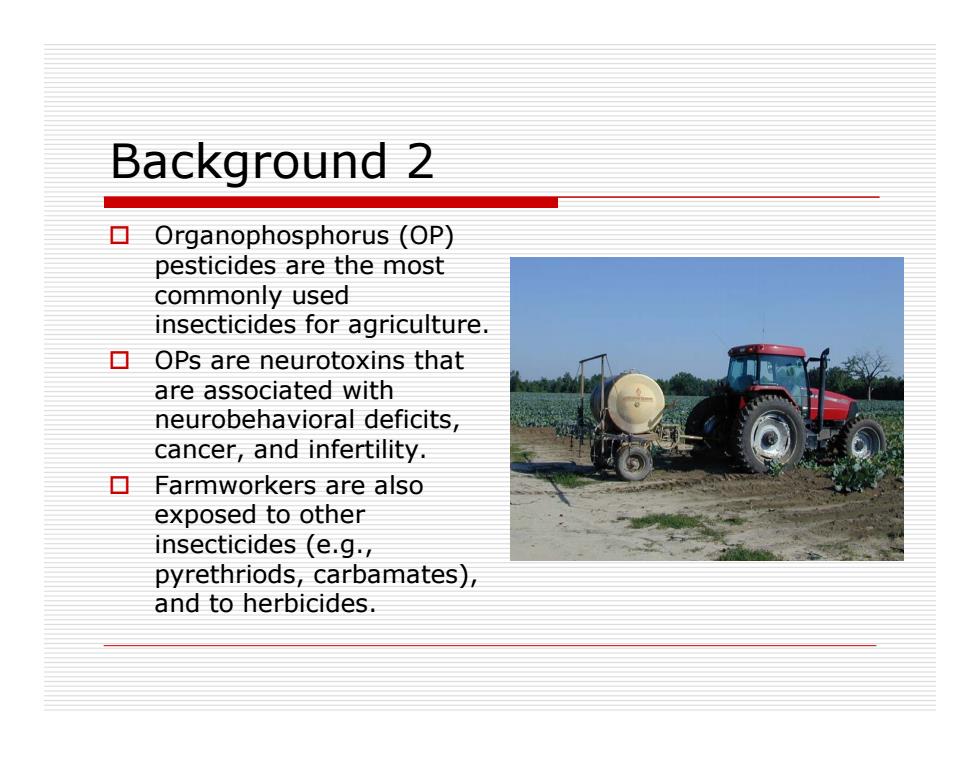
Background 2 Organophosphorus (OP) pesticides are the most commonly used insecticides for agriculture. OPs are neurotoxins that are associated with neurobehavioral deficits, cancer,and infertility. ▣Farmworkers are also exposed to other insecticides (e.g., pyrethriods,carbamates), and to herbicides
Background 2 Organophosphorus (OP) pesticides are the most commonly used insecticides for agriculture. OPs are neurotoxins that are associated with neurobehavioral deficits, cancer, and infertility. Farmworkers are also exposed to other insecticides (e.g., pyrethriods, carbamates), and to herbicides
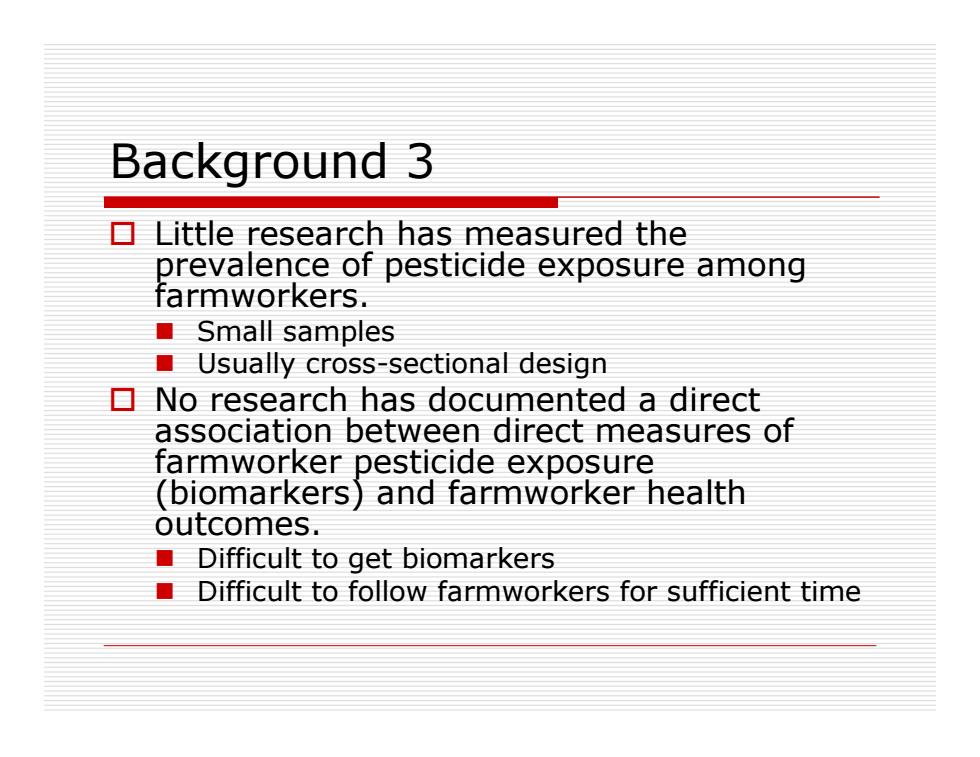
Background 3 Little research has measured the prevalence of pesticide exposure among farmworkers. Small samples Usually cross-sectional design No research has documented a direct association between direct measures of farmworker pesticide exposure (biomarkers)and farmworker health outcomes. Difficult to get biomarkers ■ Difficult to follow farmworkers for sufficient time
Background 3 Little research has measured the prevalence of pesticide exposure among farmworkers. Small samples Usually cross-sectional design No research has documented a direct association between direct measures of farmworker pesticide exposure (biomarkers) and farmworker health outcomes. Difficult to get biomarkers Difficult to follow farmworkers for sufficient time

PACE3 Specific Aims 口Document pesticide exposure levels among farmworkers in North Carolina using urinary biomarkers. Delineate the predictors of pesticide exposure levels among these farmworkers. Develop and implement a plan for disseminating risk information in culturally and educationally appropriate formats
PACE3 Specific Aims Document pesticide exposure levels among farmworkers in North Carolina using urinary biomarkers. Delineate the predictors of pesticide exposure levels among these farmworkers. Develop and implement a plan for disseminating risk information in culturally and educationally appropriate formats

Presentation Objectives Document the prevalence of the biomarkers for 7 specific OP insecticides among migrant and seasonal farmworkers in North Carolina Delineate the predictors for OP biomarkers among these farmworkers
Presentation Objectives Document the prevalence of the biomarkers for 7 specific OP insecticides among migrant and seasonal farmworkers in North Carolina Delineate the predictors for OP biomarkers among these farmworkers

PACE3 Community-based Participatory Research:Activities 288 Latino farmworkers were recruited from 44 camps in eastern North Carolina in 2007. ▣Participants were interviewed and provided urine samples up to 4 times at 1 month intervals from May to September. 939 data points at which an interview and urine sample were collected
PACE3 Community-based Participatory Research: Activities 288 Latino farmworkers were recruited from 44 camps in eastern North Carolina in 2007. Participants were interviewed and provided urine samples up to 4 times at 1 month intervals from May to September. 939 data points at which an interview and urine sample were collected

Interview Data Interviews included indicators of exposure Personal characteristics,such as ▣Age Speaking an indigenous language Work characteristics,such as Crop worked in the previous 3 days Total hours worked in the previous 3 days Pesticide safety characteristics,such as Pesticide safety training People per showerhead in camp Average times washed hands per day
Interview Data Interviews included indicators of exposure. Personal characteristics, such as Age Speaking an indigenous language Work characteristics, such as Crop worked in the previous 3 days Total hours worked in the previous 3 days Pesticide safety characteristics, such as Pesticide safety training People per showerhead in camp Average times washed hands per day

Urinary Metabolite Data Urine samples were analyzed for 7 OP pesticide urinary metabolites: TCPy (chlorpyrifos; chlorpyrifos methyl) ■CMHC(coumaphos) ■IMPY(diazinon) ■CIT(isazaphos) ■MDA(malathion) PNP(parathion;methyl parathion) DEAMPY (primiphos methyl)
Urinary Metabolite Data Urine samples were analyzed for 7 OP pesticide urinary metabolites: TCPy (chlorpyrifos; chlorpyrifos methyl) CMHC (coumaphos) IMPY (diazinon) CIT (isazaphos) MDA (malathion) PNP (parathion; methyl parathion) DEAMPY (primiphos methyl)